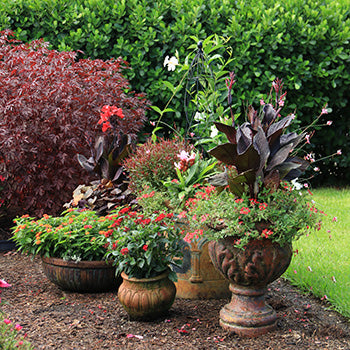Fertilizing is one of the most misunderstood gardening tasks in my experience. The good news is that it doesn’t have to be. Fertilizing your plants isn’t nearly as complicated as you might think! Read on to discover everything you need to know about fertilizing.

Fertilizing Outdoor Garden Beds and Borders
Do you need to fertilize your plants growing in garden and landscape beds and borders? Good question! If you have good
or even reasonable soil, fertilizing probably isn’t a necessity. One of the great things about nature is that it has a
system for replenishing nutrients in the soil all on its own.
You can easily check your soil’s nutrient
levels by doing a soil test. Contact your local university or cooperative extension service for a soil-testing kit,
along with instructions. These kits allow you to take samples of your soil and send them to a laboratory for analysis.
The lab will return your results, letting you know if your ground is deficient in any particular nutrients.
That said, you may wish to fertilize your garden -- or parts of it -- even if you don’t need to. Fertilizing can
help encourage faster, lusher growth on plants, and that can be particularly helpful for vegetables, herbs, and annuals
where you want to see more results quickly.
Note: Because fertilizer pushes more soft, new growth, frequently
fertilizing your plants may actually make them more susceptible to attack from pests or diseases, particularly if you’re
growing the plants in challenging situations (such as growing a sun-loving plant in too much shade).
Fertilizing Outdoor Container Gardens
Container gardens rely on you for their nutrients, so it’s helpful to fertilize them throughout the growing season. If
you haven’t fertilized your containers, you may be able to see that your plants need it when they grow more slowly,
bloom less, and their foliage fades from a rich, dark green color to a pale or yellowy green. Types of Fertilizer
There are two ways to do this. You can either use a time-release fertilizer once at the beginning of the season or use multiple applications of quick-release fertilizer throughout the course of the growing season.
Time-release fertilizers
are often in the form of dry granules or spheres. As these granules break down in the soil, they slowly release nutrients, providing a steady supply for your plants. Time-release fertilizers typically work for 6 to 12 weeks, depending on conditions.
Quick-release fertilizers
deliver nutrients immediately to the soil, so you usually see quicker response from your plants. The effects don’t last as long as time-release fertilizers, however, and depending on the nutrient, plant, and growing conditions, the added nutrients could wash out in a week or less. Quick-release fertilizers are often mixed with water, but there are also dry, granular types available, as well.
Organic fertilizers
are derived from natural sources. In addition to releasing nutrients to the soil, they may help by improving the overall quality of your soil, depending on the type. Some gardeners believe fruits, herbs, vegetables taste better when fertilized organically; other gardeners don’t taste a difference. Because they’re based on natural materials, such as manure, fish, or guano, some organic fertilizers may have a strong scent.
Synthetic fertilizers
are not natural, but formulated by scientists or manufactured. They’re almost always faster-acting than organic fertilizers, and come in a wide variety of forms that, in some cases, are more convenient or easy to use in the garden. You may be able to find synthetic fertilizers designed for specific garden situations, such as acidic soil, or that concentrate on one nutrient your soil may be lacking so you’re not adding nutrients your soil doesn’t need.No matter what type of fertilizer you use, be sure to follow the directions on the product packaging carefully. If you use too much fertilizer at one time -- or use fertilizer too frequently -- you can inadvertently harm (or even kill) your plants by burning their roots.
















